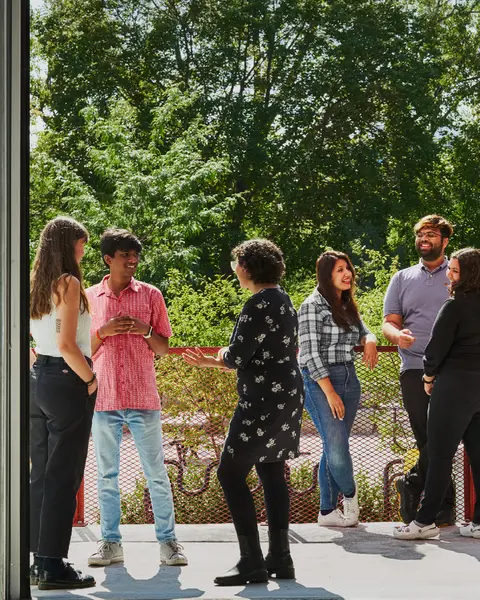Student Life and Resources
Founded in 1993 by Professor Yoshua Bengio, Mila now brings together over 1,200 student researchers and more than 140 professors from Université de Montréal, McGill University, Polytechnique Montréal and HEC Montréal.
Founded in 1993 by Professor Yoshua Bengio, Mila now brings together over 1,200 student researchers and more than 140 professors from Université de Montréal, McGill University, Polytechnique Montréal and HEC Montréal.
Thanks to a unique collaborative model and values rooted in openness and social awareness, Mila offers its student community an inclusive and stimulating environment for research and innovation, while contributing to the growth of an ecosystem that inspires the development of artificial intelligence (AI) for the common good.
Mila also includes professors from Université Laval, Université de Sherbrooke, École de technologie supérieure (ÉTS) and Concordia University, as well as numerous industrial partners from Canada and around the world.

Get to know a few members of our community and find out why they chose Mila for their academic journey.
Beheshteh T. Rakhshan is a PhD student at Université de Montréal. She is focusing her AI research on the treatment of stage 4 cancer.
Dongyan Lin is a PhD student at McGill University. When she is not exploring Montreal’s parks and enjoying its infamous bagels, Dongyan studies how the fields of neuroscience and AI can compliment and advance one another.
Jose Gallego-Posada is a PhD student in computer science at Université de Montréal. At home, he enjoys making arepas, but when he’s at Mila working on constrained optimization, his life becomes “Jose in Wonderland".

Mila’s student researchers work in an exceptional environment in the heart of Mile-Ex, a vibrant Montreal neighbourhood nestled between the Mile-End, Little Italy and Parc-Extension. Inaugurated in 2019, our modern spaces on Saint-Urbain Street are designed to foster interactions between the university community, industrial partners, and Mila staff.
Thanks to the ongoing dedication of Mila members, our student researchers benefit from a wide range of resources and amenities to enrich their academic careers and ensure their well-being.
The Black at Mila collective is dedicated to increasing the presence and inclusion of Black researchers and professionals in AI at Mila by creating spaces to share ideas, foster collaborations, mentorship, and advocacy.
The Mila Entrepreneurship Lab runs a number of programs aimed at developing students’ entrepreneurial spirit and supporting young entrepreneurs in the growth of their projects. The Lab also plays a key role in the development of startups originating in the community.
Comprised of Mila staff and students, the Mental Health Committee carries out a variety of initiatives to encourage mental health awareness, acceptance and action in the community and provides appropriate resources when needed.
TRAIL is a responsible AI training program specifically designed for students at Mila. Interactive and practical, it provides participants with the fundamental knowledge, skills, and tools necessary to design and conduct their research projects responsibly.
Tea talks are scientific keynote lectures usually held on Friday mornings. These talks are technical presentations aimed at the level of Mila researchers on a variety of subjects spanning machine learning and are open to the public.
Women@Mila is a grassroots initiative led by student and staff volunteers — focused on enriching the social, academic and professional experiences for all women working and studying at Mila through community-building events and initiatives.
One of Canada's three largest metropolises, alongside Toronto and Vancouver, Montreal offers many opportunities for students who choose to live here. Recognized worldwide for its cultural vitality, Montreal is a cosmopolitan city where more than 120 cultural communities coexist. It also stands out as Canada's leading city for university research in AI, offering numerous business and employment opportunities.
For more information, visit I Choose Montréal.